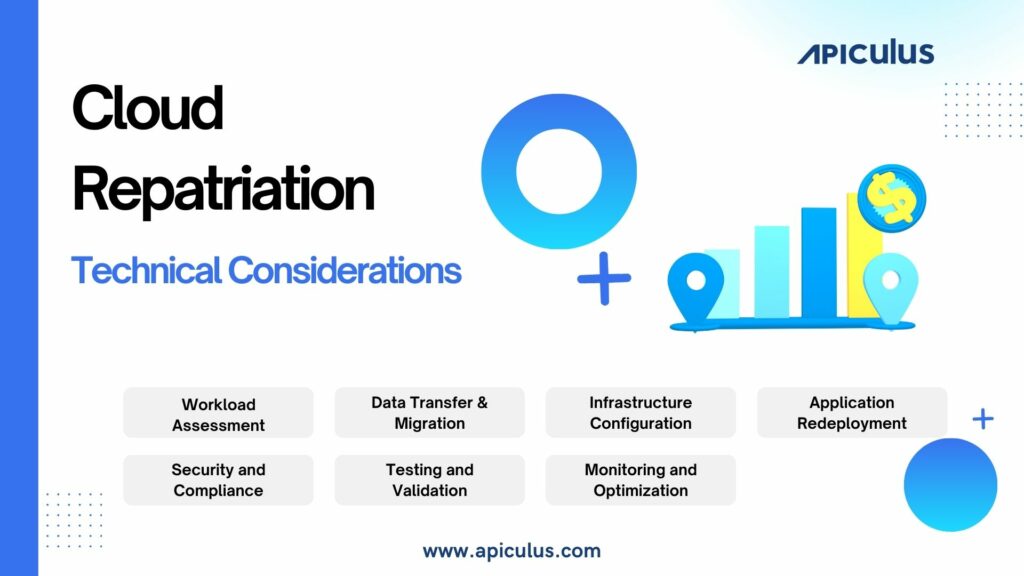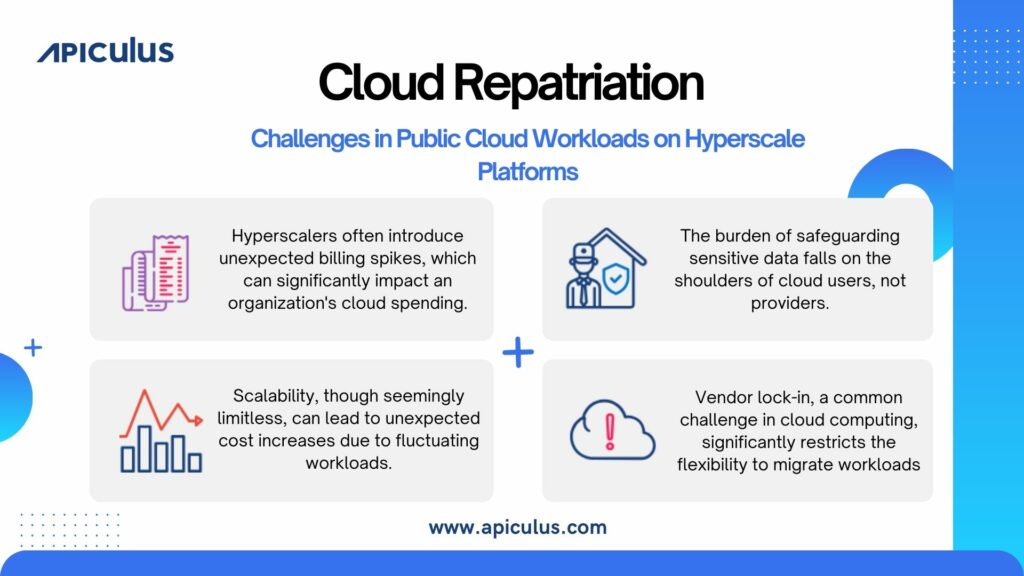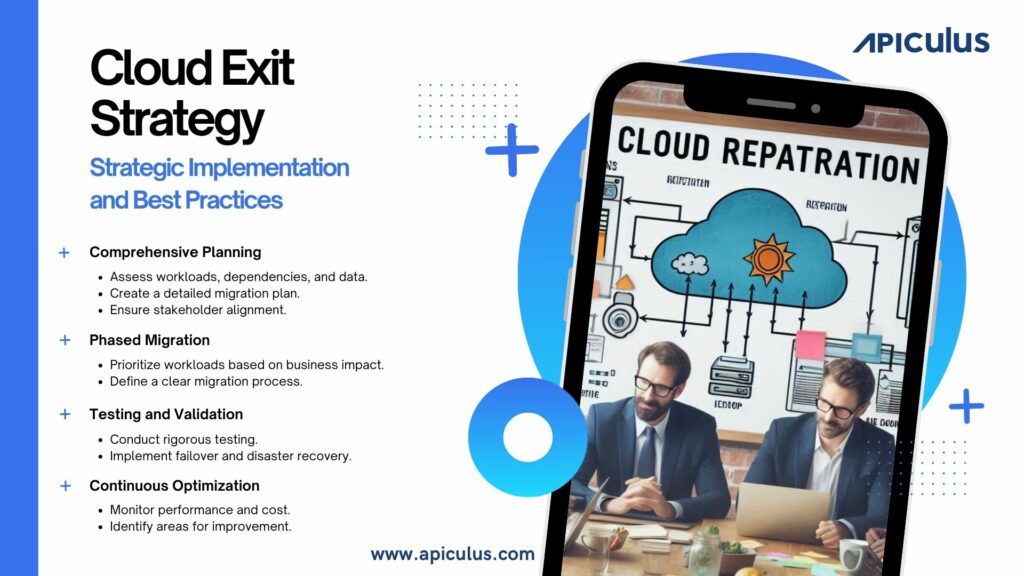Cloud repatriation, which involves migrating data, applications, or workloads from large public clouds back to private cloud environments, has become popular among businesses aiming to optimise their infrastructure and reduce costs. This guide delves into the technical aspects of developing a robust cloud exit strategy through cloud repatriation, offering valuable insights for businesses contemplating this transition.
Understanding Cloud Exit Strategy:
A cloud exit strategy, often referred to as cloud repatriation, involves the deliberate process of migrating applications, data, and services from a public cloud environment to an on-premises infrastructure or an alternative cloud platform. This strategic decision is often driven by a combination of factors including cost optimization, security concerns, data sovereignty requirements, performance issues, or evolving business needs.
To successfully leave the cloud, you need a carefully planned strategy. This includes understanding your current cloud setup, choosing which workloads to bring back, creating a detailed migration plan, and moving your data without interrupting your business.
By adopting a proactive approach to cloud exit planning, organizations can mitigate risks, enhance flexibility, and maintain control over their IT infrastructure. A cloud exit strategy isn’t just a backup plan. It’s a way to use your cloud resources wisely and reach your business goals.
What is Cloud Exit Strategy?
Cloud exit strategy is a contingency plan that outlines how an organization can smoothly transition its data, applications, and services out of a cloud computing environment. It’s essentially a proactive approach to ensure business continuity and mitigate risks associated with cloud dependency.
A well-defined cloud exit strategy addresses potential challenges like vendor lock-in, unexpected cost increases, service disruptions, and evolving data privacy regulations. It provides a roadmap for organizations to regain control over their data, migrate applications to alternative platforms, and maintain business operations without significant disruptions.
Also Read – Navigating the Pros and Cons: Benefits and Challenges of Cloud Repatriation
The Importance of a Cloud Exit Strategy
In today’s digital age, cloud computing has become an indispensable tool for businesses of all sizes. It offers scalability, flexibility, and cost-effectiveness. However, as convenient as cloud solutions are, it’s crucial to have a well-defined cloud exit strategy in place.
Why is a Cloud Exit Strategy Important?
- Vendor Lock-In Mitigation:
- Dependency Reduction: Cloud providers often offer proprietary services and tools that can make it difficult to migrate to another platform.
- Future-Proofing: A well-designed exit strategy ensures your business isn’t tied to a single vendor, allowing for flexibility and adaptability to future technological advancements.
- Data Sovereignty and Compliance:
- Data Control: Having a clear exit plan empowers you to regain control over your data, ensuring it’s stored and processed according to your specific needs and regulatory requirements.
- Compliance Adherence: A robust exit strategy helps you maintain compliance with data privacy regulations like GDPR and CCPA, especially when dealing with sensitive information.
- Cost Optimization and Efficiency:
- Cost Analysis: By regularly reviewing your cloud usage and potential exit costs, you can identify opportunities to optimize expenses and reduce unnecessary spending.
- Efficient Resource Allocation: An exit strategy can help you rightsize your cloud infrastructure, ensuring that you’re only paying for the resources you truly need.
- Business Continuity and Disaster Recovery:
- Contingency Planning: A well-defined exit strategy serves as a crucial part of your business continuity plan, enabling you to recover from disruptions or security breaches.
- Data Recovery and Migration: In the event of a disaster, having a plan to migrate your data and applications to a different cloud provider or on-premises infrastructure can minimize downtime.
- Strategic Flexibility:
- Adaptability to Change: A cloud exit strategy allows your business to adapt to changing market conditions, technological advancements, and evolving business needs.
- Future-Proofing Your Infrastructure: By having a clear path to migrate or exit the cloud, you can ensure that your IT infrastructure remains relevant and efficient.
Technical Considerations for Cloud Repatriation:

- Workload Assessment: Effectively identifying suitable workloads for repatriation is crucial. A meticulous assessment of performance metrics, resource utilization, cost-benefit analysis, and alignment with business objectives is essential. This process involves analyzing workload characteristics, dependencies, and integration points to determine the feasibility and potential impact of repatriation.
- Data Transfer and Migration: Developing robust data migration strategies is paramount for successful repatriation. Organizations must address challenges such as data volume, format compatibility, network bandwidth limitations, and data quality issues. Employing specialized data migration tools and techniques can streamline the process and minimize disruptions.
- Infrastructure Configuration: Repatriated workloads require adequate infrastructure to support their operations. Proper planning and provisioning of servers, storage, networking, and security components are essential. Optimizing resource allocation, ensuring high availability, and implementing load balancing mechanisms are crucial for delivering optimal performance and scalability.
- Application Redeployment: Adapting applications to the on-premises environment often necessitates re-platforming or re-architecting to align with the new infrastructure. Optimizing application performance, addressing compatibility issues, and ensuring seamless integration with existing systems are critical considerations.
- Security and Compliance: Establishing a robust security framework is essential to protect sensitive data during and after repatriation. Implementing appropriate security controls, such as encryption, access management, and intrusion detection systems, is crucial. Adherence to industry regulations and compliance standards is mandatory to maintain data integrity and privacy.
- Testing and Validation: Thorough testing is indispensable to ensure the successful operation of repatriated workloads. Functional, performance, and security testing should be conducted to identify and address potential issues. Load testing helps assess the system’s capacity to handle expected workloads, while security testing helps identify vulnerabilities.
- Continuous Monitoring and Optimization: Post-repatriation monitoring is crucial to assess system performance, identify bottlenecks, and optimize resource utilization. Implementing performance monitoring tools and establishing key performance indicators (KPIs) is essential for maintaining system health and identifying areas for improvement.
By carefully considering these technical aspects and implementing appropriate strategies, organizations can mitigate risks and achieve successful cloud exit strategies.
Also Read – The Basics of Cloud Repatriation: What You Need to Know
Technical Challenges and Mitigation Strategies:
Cloud repatriation, while offering potential benefits, presents a range of technical challenges that require careful consideration and strategic mitigation.

- Data Transfer Complexity: Transferring vast amounts of data from the cloud to on-premises infrastructure can be a complex and time-consuming process. Organizations must address challenges such as network bandwidth limitations, data extraction formats, and potential data inconsistencies. Implementing data transfer acceleration tools, optimizing data transfer windows, and conducting thorough data validation can help mitigate these complexities.
- Resource Allocation and Skill Requirements: Successful cloud exit demands adequate resources and specialized skills. Organizations may face challenges in acquiring necessary hardware, software, and personnel. Building a skilled team or partnering with external experts can bridge these gaps. Moreover, effective project management and resource allocation are crucial for timely and efficient repatriation.
- Integration and Compatibility: Integrating repatriated systems with existing on-premises infrastructure can pose significant challenges. Ensuring compatibility between applications, databases, and network components is essential. Addressing data synchronization issues and potential performance bottlenecks requires careful planning and testing.
- Performance Optimization: Achieving optimal performance in the repatriated environment is critical. Factors such as hardware specifications, network infrastructure, and application optimization play a vital role. Performance monitoring, load testing, and fine-tuning configurations are essential to identify and address performance bottlenecks.
Also Read – VMware Exodus: 5 Reasons Why Apache CloudStack is the Superior Cloud Management Choice
Strategic Implementation and Best Practices for Cloud Exit Strategy:
Cloud exit, while offering potential benefits, requires meticulous planning and execution. This section delves into the critical steps and best practices to ensure a smooth transition.

- Comprehensive Planning: A successful repatriation begins with a thorough understanding of the current cloud environment. This involves a comprehensive assessment of workloads, dependencies, and data to identify suitable candidates for repatriation. Creating a detailed migration plan, outlining timelines, resource allocation, and potential risks, is essential for a structured approach. Engaging key stakeholders across the organization ensures alignment and buy-in for the repatriation initiative.
- Phased Migration Approach: To minimize disruptions and mitigate risks, adopting a phased migration strategy is recommended. Prioritizing workloads based on business impact, technical complexity, and cost-benefit analysis is crucial. A well-defined migration process, including data migration, infrastructure setup, application testing, and cutover planning, is essential for a seamless transition.
- Testing and Validation: Thorough testing is imperative to ensure the repatriated environment functions as expected. Rigorous testing of applications, databases, and network connectivity uncovers and rectifies potential issues before full-scale migration. Implementing failover mechanisms and disaster recovery plans provides an additional layer of protection against unforeseen challenges.
- Continuous Optimization and Monitoring: Cloud repatriation is an ongoing process that requires continuous monitoring and optimization. Tracking performance metrics, analyzing cost, and identifying areas for improvement are essential for maximizing the benefits of repatriation. Regular assessments of the repatriated environment help in identifying opportunities for further optimization and addressing emerging challenges.
Also Read – Multi-Cloud Strategy: Your Key to Simplifying the Complex
Conclusion on Cloud Exit Strategy:
Cloud repatriation, which is a crucial component of a cloud exit strategy, requires careful planning, technical expertise, and strategic execution. Successfully implementing a robust cloud exit strategy through cloud repatriation involves navigating workload assessment, data migration, infrastructure configuration, and addressing technical challenges.
At Apiculus, we specialise in assisting businesses with the technical complexities of cloud repatriation. We empower them to develop comprehensive and customized cloud exit strategies that meet their specific needs.

Sunando comes from an IT services background, and has over 23 years experience with companies like Orange Business Services, Spectranet, Sify and NTT-NetMagic wherein he was responsible for Business Strategy, Sales, Alliances, Product Development and Pre-sales functions. At IndiQus, he drives the entire business strategy, and also leads the HR and Finance teams. Sunando did his SMP from IIM Calcutta.

